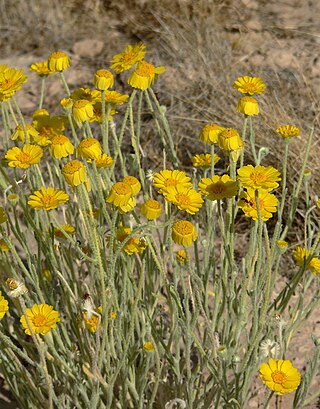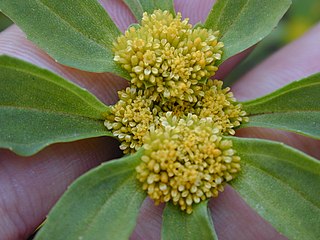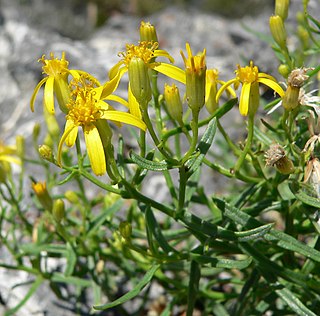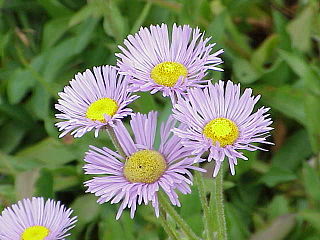
Leontodon saxatilis is a species of hawkbit known by the common names lesser hawkbit, rough hawkbit, and hairy hawkbit. It is native to Europe and North Africa but can be found in many other places across the globe as an introduced species and often a noxious weed. This is a dandelion-like herb growing patches of many erect, leafless stems from a basal rosette of leaves. The leaves are 2 to 15 centimeters long, 0.5 to 2.5 centimeters wide, entire or lobed, and green in color. Atop the stems are solitary flower heads which are ligulate, containing layered rings of ray florets with no disc florets. The florets are yellow with toothed tips. The fruit is a cylindrical achene with a pappus of scales. Fruits near the center of the flower head are rough, while those growing along the edges of the head are smooth.

Agoseris glauca is a species of flowering plant in the family Asteraceae known by the common names false dandelion, pale agoseris, prairie agoseris, and short-beaked agoseris. It is native to western North America.

Symphyotrichum frondosum is a species of flowering plant in the family Asteraceae native to western North America. Commonly known as short-rayed alkali aster, it is an annual or perennial herbaceous plant that may reach 140 centimeters tall.

Almutaster is a North American genus of plants in the family Asteraceae containing the single species Almutaster pauciflorus, which is known by the common name alkali marsh aster. It is native to Canada, the Western United States, and northern and central Mexico. The genus is named for botanist Almut Gitter Jones.

Baileya pleniradiata is a North American species of flowering plant in the daisy family, known by the common name woolly desert marigold. It is native to desert regions of the southwestern United States and northern Mexico, where it grows in sandy habitats. It has been found in the States of Chihuahua, Sonora, Baja California, Arizona, Utah, and Nevada.

Flaveria trinervia is a species of flowering plant in the family Asteraceae known by the common names clustered yellowtops, speedyweed, and yellow twinstem. It is native to parts of the Americas, including the southeastern and southwestern United States, most of the Bahamas, Mexico, Belize, and parts of the Caribbean, especially Cuba, Cayman Islands, Jamaica, Hispaniola, Puerto Rico and Barbados. It is also known in many other places as an introduced species and often a noxious weed, such as in Hawaii.

Solidago nemoralis is a species of flowering plant in the family Asteraceae. It is native to North America, where it is widely found in Canada and the United States. Its common names include gray goldenrod, gray-stem goldenrod, old-field goldenrod, field goldenrod, prairie goldenrod, dwarf goldenrod, and dyersweed goldenrod.
Malacothrix stebbinsii is a species of flowering plant in the family Asteraceae known by the common name Stebbins' desertdandelion. It is native to the southwestern United States and northern Mexico where it grows in deserts, scrub, and woodlands. It is an annual herb producing a hairless stem up to about 60 centimeters in maximum height. The leaves are lined with narrow lobes. The inflorescence is an array of flower heads with ray florets under a centimeter long and white to light yellow in color.

Grindelia ciliata is a species of flowering plant in the family Asteraceae known by the common names Spanish gold, goldenweed, and waxed goldenweed.

Pyrrocoma apargioides is a species of flowering plant in the family Asteraceae known by the common name alpineflames. It is native to the western United States from the Sierra Nevada of California east to Utah, where it grows in the forests and meadows of high mountains. It is a perennial herb growing from a taproot and producing one or more stems to 30 centimeters in length. The stems are decumbent or upright, reddish, and hairless to slightly woolly. Most of the leaves are located around the base. They are thick and leathery, lance-shaped with large sawteeth along the edges, often center-striped in white, and measure up to 10 centimeters long. The inflorescence is usually a single flower head lined with centimeter-long phyllaries which are reddish to green with red edges. The head has a center of yellow disc florets and a fringe of ray florets which are yellow, often splashed with red along the undersides, measuring up to 1.6 centimeters in length. The fruit is an achene which may be well over a centimeter in length including its pappus.

Pyrrocoma carthamoides is a species of flowering plant in the family Asteraceae known by the common name largeflower goldenweed. It is native to western North America from British Columbia to northeastern California to Wyoming, where it is known from grassland, woodlands, forests, barren areas, and other habitat. It is a perennial herb growing from a taproot and producing one or more stems to about half a meter in maximum length, the stems reddish-green and leafy. The largest leaves are at the base of the stem, measuring up to 20 centimeters long, lance-shaped with spiny sawtoothed edges. Leaves higher on the stem are smaller and hairier. The inflorescence is a single flower head or a cluster of up to four. Each bell-shaped head is lined with phyllaries each up to 2 centimeters long. It has many yellow disc florets surrounded by a fringe of yellow ray florets up to 7 millimeters long; ray florets are occasionally absent. The fruit is an achene which may be well over a centimeter in length including its pappus.

Raillardella scaposa is a species of flowering plant in the family Asteraceae known by the common name stem raillardella. It is native to the Sierra Nevada of California and western Nevada and parts of the southern Cascade Range in Oregon, where it grows in varying habitat types, from wet to dry and exposed to shaded. It is a rhizomatous perennial herb growing in a clump of rosetted basal leaves. The leaves are linear to lance-shaped, up to 16 centimeters long, and glandular. The plant produces an inflorescence just a few centimeters to half a meter tall consisting of flower heads which are cylindrical to hemispheric in shape. Each head contains many yellow to orange disc florets and sometimes a few ray florets. The fruit is a long, narrow achene 1 to 2 centimeters in length including its pappus of plumelike bristles.

Rudbeckia californica is a species of flowering plant in the family Asteraceae, known by the common name California coneflower.
Packera pseudaurea is a species of flowering plant in the aster family known by the common name falsegold groundsel. It is native to North America, where it can be found in western and central parts of Canada and the United States. It grows in mountain habitat such as meadows, streambanks, and woodlands.

Senecio spartioides is a species of flowering plant in the aster family known by the common name broom-like ragwort. It is native to the western United States as far east as the Dakotas and Texas, and northern Mexico. It can be found in dry, rocky, often disturbed areas in a number of habitat types. It is a subshrub which can exceed a meter in height, its arching stems growing from a woody-topped taproot. The leaves are linear in shape and up to 10 centimeters long. The leaves usually have smooth, unlobed edges, but slightly lobed leaves are seen at times. The leaves are evenly distributed along the stems, the ones low on the stems withering away early, giving the plant a naked appearance on the lower half while the top is still lush green and blooming. The inflorescences are spreading, flat-topped arrays of many cylindrical flower heads. The heads contain yellow disc florets and generally either 5 or 8 ray florets each about a centimeter long.

Erigeron glabellus is a North American species of flowering plants in the family Asteraceae, called the streamside fleabane.

Erigeron leiomerus is a rare species of flowering plant in the family Asteraceae known by the common names rockslide yellow fleabane or rockslide fleabane. It is native to the western United States, primarily in the Rocky Mountains and the Great Basin. It has been found in Montana, Idaho, Nevada, Utah, Wyoming, Colorado, and New Mexico.
Erigeron nivalis is a North American species of flowering plant in the family Asteraceae, called the northern daisy. It is widespread across much of western North America from Alaska east to Northwest Territories and south as far as California and New Mexico.

Erigeron procumbens is a North American species of flowering plant in the family Asteraceae known by the common name Corpus Christi fleabane, the name referring to a coastal city in Texas. The species grows along the coastal plain and coastal strand of the Gulf of Mexico, in the states of Veracruz, Tamaulipas, Texas, Louisiana, and Mississippi.
Erigeron vreelandii is a North American species of flowering plant in the family Asteraceae known by the common names sticky tall fleabane and Vreeland's erigeron. It grows in northwestern Mexico and in the southwestern United States.

















